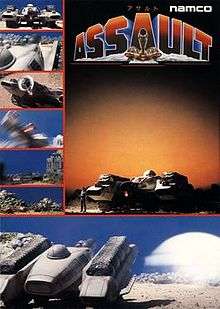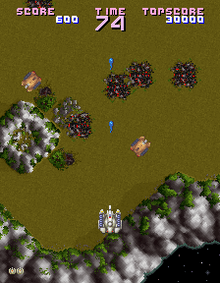Assault (1988 video game)
Assault[lower-alpha 1] is a 1988 multi-directional shooter arcade game developed and published by Namco. It was licensed to Atari Games for release in North America. Controlling a caterpillar-tread tank, the player is tasked with completing each of the game's eleven stages while shooting enemies and avoiding projectiles. It uses a twin-stick control layout, similar to games such as Battlezone. The plot involves the human race searching for new planets after Earth reaches its maximum population - after discovering an exo-planet 35,000 light years away from the Milky Way, they enslave the planet's natives and take control, leading to the natives vowing to abolish the humans and bring peace to their world.
| Assault | |
|---|---|
 Japanese flyer | |
| Developer(s) | Namco |
| Publisher(s) |
|
| Designer(s) | Kunio Ogawara |
| Composer(s) | Shinji Hosoe |
| Platform(s) | Arcade |
| Release | |
| Genre(s) | Multi-directional shooter |
| Mode(s) | Single-player, multiplayer (alternating turns) |
| Cabinet | Upright |
| Arcade system | Namco System 2 |
| CPU | 2x Motorola 68000 @ 12.288 MHz, 1x Motorola M6809 @ 3.072 MHz, 1x Hitachi HD63705 @ 2.048 MHz |
| Sound | 1x Yamaha YM2151 @ 3.57958 MHz, 1x C140 @ 21.39 kHz |
| Display | Vertical orientation, raster, 224 x 288 resolution |
Assault was one of the first games to use the Namco System 2 arcade hardware, capable of sprite scaling and rotation. Music was composed by Shinji Hosoe while designs for the player's tank and enemies were designed by Gundam artist Kunio Ogawara. Upon release, Assault was met with favorable reviews, with critics applauding the game's graphics, controls and usage of sprite-scaling.
A Japan-only follow-up, Assault Plus, was released the same year. Assault is included in the compilation Namco Museum Vol. 4 for the PlayStation in 1997, and was later released for the Japanese Wii Virtual Console in 2009.
Gameplay

Controlling a caterpillar-tread tank, the player is tasked with completing each of the game's eleven stages by destroying enemies and avoiding projectiles. Similar to Battlezone (1980), the game features a twin-stick control scheme, where pushing the joysticks forward will cause the tank to move forward and pushing them backwards will make it reverse direction.[1] Turning is done by moving only one joystick forward. Pushing both joysticks left or right will flip the tank over, which can allow the player to move through narrow spots. Pushing both joysticks away from each other will allow the player to do a Power Wheelie, which will allow it to fire powerful grenades at enemies. The player can also perform Rapid Rolls (strafing) by pushing both joysticks either left or right.[2]
The game is composed of eleven stages, which include large deserts, mechanical bases, forests and rivers.[1] The end of each stage features a large mechanical structure that must be defeated, which will shoot projectiles at the player.[1] Stages also contain large "Jump Pads" that will catapult the tank into the sky when touched,[2] allowing the player to shoot powerful blasts towards enemies on the ground and to view other sections of the map.[1] A flashing arrow will appear on-screen to point the player towards the level exit.[2]
Plot
In the year 2199, Earth reached its maximum population point, causing humans to venture throughout the Milky Way in search of potential new planets to inhabit. 35,000 light years away from the galaxy, humans had discovered a planet with large floating continents, inhabited by a civilization far more advanced than those on Earth. A large war ensued that lead to the downfall of the natives, as humans began constructing large fortresses and buildings to strengthen their positions. Feeling the humans did not deserve to rule by force, a lone native pilots a caterpillar-treaded tank in an effort to vanquish the humans and bring peace to the planet.
Development and release
Assault was originally released by Namco in Japan in April 1988,[3] later licensed to Atari Games for release in North America.[4] The soundtrack was composed by Shinji Hosoe, while designs for the player's tank and enemies were designed by Gundam artist Kunio Okawara.[3] Assault was one of the first games to use the Namco System 2 arcade board, which was capable of sprite rotation and scaling.[4]
Reception
| Reception | ||||||||
|---|---|---|---|---|---|---|---|---|
| ||||||||
| ||||||||
Assault was met with a favorable reception from critics, who praised the game's graphics, controls and sprite-scaling techniques. Japanese video game magazine Gamest awarded the game the eighth "Best Shooting Award" and "Best Ending Award", as well as the eleventh "Annual Hit Game" award in January 1998.[7]
Nick Kelly of Commodore User was impressed with the game's technological capabilities, notably the use of sprite scaling and rotation, saying that it features "impressive multi-directional scrolling".[5] He also praised the twin-stick control layout for providing a more 'hands-on' approach to the game, favorably comparing it to Atari's Vindicators.[5] Kelly concluded his review by writing that the game was "a good idea well executed".[5] Power Play gave a similar response, calling its scrolling techniques "unique" and its music a "true celebration". They also applauded the game's attention to detail, particularly with the player's tank slowing down upon moving over rough surfaces.[6]
Legacy
Assault is one of the five titles in Namco Museum Vol. 4 for the PlayStation in 1997.[8] In his review of the collection, Jeff Gerstmann of GameSpot called Assault "the gem of the package".[8] Crispon Boyer of Electronic Gaming Monthly stated that both it and Ordyne were the only games in the collection "worth a darn", calling Assault one of his favorite arcade games.[9] Dan Hsu wrote that the game was only worth playing with an analog controller to get the full arcade experience,[9] while Shawn called it one of the best games in the compilation.[9]
A Japanese Wii Virtual Console digital download was released on June 9, 2009.[10]
Shortly after Assault was released, a Japan-only follow-up, Assault Plus, was published.[11] It has altered visuals and enemy designs, as well as presenting the stages in an episodic format rather than a linear run. Plus is included in Namco Museum Vol. 4 as a bonus game that can be unlocked with a cheat code.[12]
References
- Assault Operator's Manual. Atari Games. 1988. p. 10. Retrieved 30 July 2019.
- Namco Museum Vol. 4 instruction booklet. Namco. 30 June 1997. pp. 20–22.
- Narusawa, Daisuke (1 March 1991). The Namco Book. JICC Publishing Bureau. ISBN 978-4-7966-0102-3.
- "Assault - Videogame by Atari". Killer List of Videogames. Archived from the original on 25 March 2019. Retrieved 30 July 2019.
- Kelly, Nick (November 1988). "Assault" (November). EMAP. Commodore User. p. 117. Archived from the original on 2 February 2019. Retrieved 30 July 2019.
- "Assault" (in German) (December). Power Play. December 1988. p. 82. Archived from the original on 30 July 2019. Retrieved 30 July 2019.
- ゲーメスト大賞11年史 (in Japanese) (5 ed.). Gamest. 17 January 1998. pp. 22–23. ISBN 9784881994290.
- Gerstmann, Jeff (2 May 2000). "Namco Museum Volume 4 Review". GameSpot. Archived from the original on 30 July 2019. Retrieved 30 July 2019.
- "Namco Museum 4" (96). Electronic Gaming Monthly. July 1997. p. 61.
- Sakei, Kenji (5 June 2009). "バンダイナムコ、6月9日に「アサルト」を バーチャルコンソール アーケードで配信". GAME Watch. Impress Group. Archived from the original on 20 April 2019. Retrieved 30 July 2019.
- "Assault Plus - Videogame by Namco". Killer List of Videogames. Archived from the original on 30 May 2019. Retrieved 30 July 2019.
- "Tricks of the Trade". Electronic Gaming Monthly. No. 99. Ziff Davis. October 1997. p. 62.